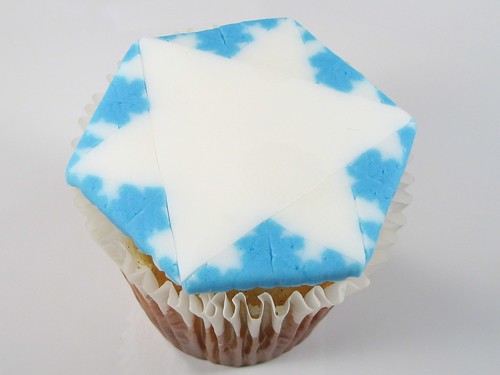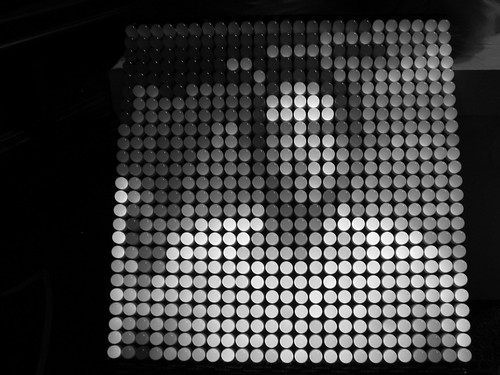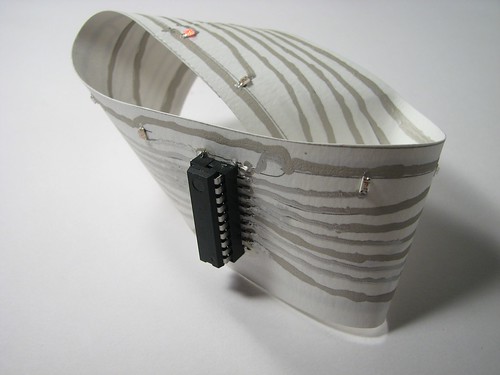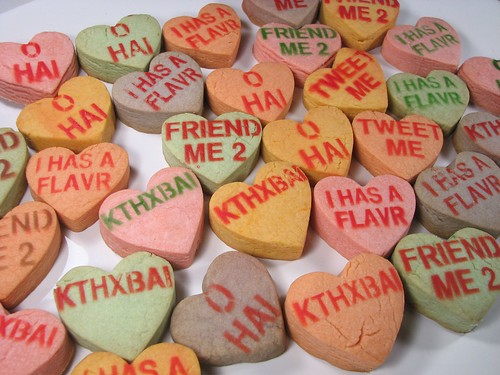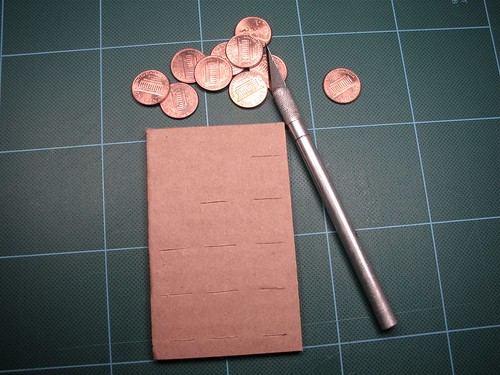The Koch Snowflake is a neat fractal shape… that you can make in your kitchen.
All posts by Windell Oskay
Giant seven segment displays
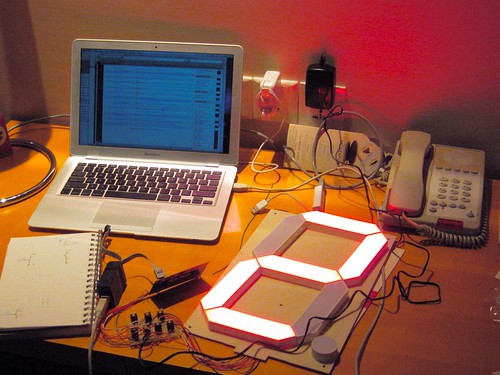
As part of the China trip last week, we had a little scavenger hunt, where the challenge was to build something with parts and tools acquired at the electronics markets.
Here’s what I found: a single-digit seven-segment LED display with twelve inch digit height. (Whoa!)
Continue reading Giant seven segment displays
A visit to the electronics markets of Shenzhen
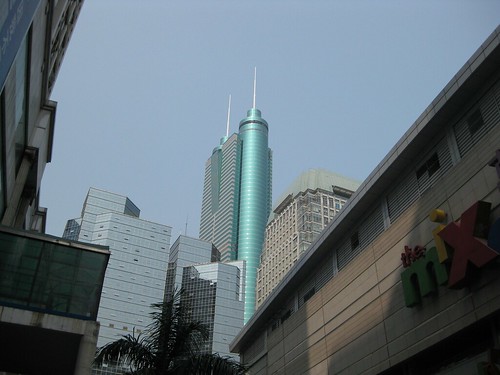
I’ve just returned from a week long trip to Shenzhen, China in a “geek tour” trip organized by Bunnie Huang, with some assistance from the fine folks at PCH International.
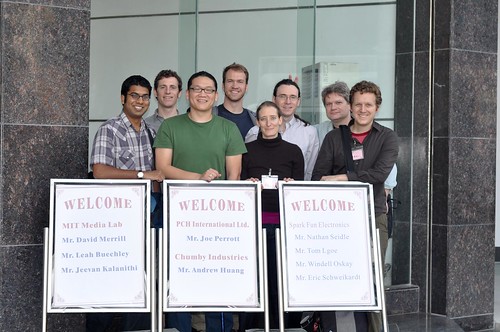
More than just a tour, this was also a tiny conference of open source and physical computing hardware hackers.
The participants were (from left to right above): Jeevan Kalanithi, Eric Schweikardt, Bunnie Huang, Nathan Seidle, Leah Buechley, myself (Windell Oskay), Tom Igoe, and David Merrill.
(Thanks to Tom Igoe for the photo. Thanks also to Dale Dougherty for helping to get such a great set of folks in contact for the trip!)
Shenzhen is a vibrant, bustling, young, and modern city of 8 million in southern China. Just across the border from Hong Kong, Shenzhen and the region around it comprise one of the most active and important manufacturing centers in the world today. (Hint: “made in China” sounds familiar.) The city itself is filled with people, restaurants, smog and shiny skyscrapers. At night freakishly large LED billboards illuminate the sides of apartment buildings and animated RGB neon displays ripple above nightclubs and bars. With a few more flying cars, it might do a good impression of Blade Runner‘s Los Angeles.
For me personally, one of the most interesting parts of this trip was spending some time in the vast electronic markets of downtown Shenzhen. The building pictured above, the SEG Electronic Market, is a focal point in the markets. Bunnie wrote quite a bit about this place two years ago (and it’s all true).
Continue reading A visit to the electronics markets of Shenzhen
Video Peggy in action
For a while we’ve been meaning to try out Jay Clegg’s TWI-video hack for the Peggy 2, and we must say, it’s pretty nifty. Using this routine, we can take webcam video (e.g., from our MacBook Pro’s built-in camera), sample it in a Processing routine, and send it to be displayed on the 625 LEDs of the Peggy 2.
Continue reading Video Peggy in action
Linkdump: February 2009
- Help fund linux projects
- Arduino-based Light Switch Complicator
- Down with Magenta!
- This Hard drive shredding video is strangely hypnotic.
- Some of you will think that this sign is funny.
- Ghostie Cookies
- Game of Life Generator
- One frame per game
- Designers beware! (Caution: JPEG artifacts)
- Layered Jello!
- MPG or GPM?
- DIY Flexible Circuits
- We’ve just updated our list of Resources for getting started with AVRs
- Guilloché Pattern Generator
- sierpinski carpet sponges (on Etsy too!)
- Nice knobs!
- Epic cupcake mosaic.
A single sided circuit board
In electronics, it is common to talk about single sided circuit boards. The most common type is a circuit board that only has printed wiring on one side, and components on the other side. There are also surface-mount boards, where all the wiring and components sit on one side. But aren’t all of those reallyjust two-sided circuit boards where you only put components on one of the sides?
Here we present a method of making your own authentic single-sided circuit board.
Continue reading A single sided circuit board
Improved Custom Message Hearts
In some ways, we really like candy message hearts. They make good ammo, you can stamp them with your own messages, they make halfway decent sidewalk chalk, and they do bizarre things if you cook them.
On the other hand, you may or may not like the way that these things taste. (To us, many years ago, they compared very favorably to the other varieties of sidewalk chalk that we had tried.) In either case there is certainly some room for culinary alternatives.
Read on and learn how to make your own highly edible custom cookie message hearts.
A tale of two Meggies
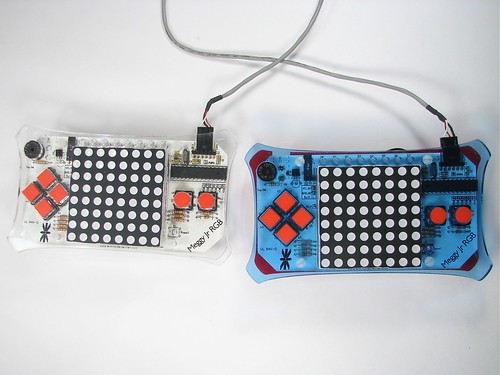
The Meggy Jr RGB has an open serial port that– thus far– hasn’t been used much for gameplay. Something was missing, which turns out to have been this cable that can hook two Meggy Jr’s (Er, Meggies?) together.
Even neater, this cable can be used to provide serial connections between any two of most types of Arduino-compatible devices that normally are programmed through a FTDI USB-TTL cable. This includes not only Meggy Jr RGB, but also the Arduino Pro, the current-revision LilyPad Arduino and the DC Boarduino. (Note: BBB and RBBB users: You can play too, once you wire up CTS# to ground.)
And the cable itself? You can make it yourself– in a couple of minutes– from a standard cable that costs about a buck. :)
Linkdump: January 2009
- We’re considering a font change for our site to FF Mt.
- Scarf for The Doctor. I’ll have to check to see which version mine is.
- We are Predictably Irrational.
- Bad Movie Bingo!
- Old Catalog Photosets e.g. Ward’s 1928 MidWinter Sale (via Draplin Design Co.)
- Lovely Package
- Octopus sticker
- Another reason to support mass transit
- Cats and Pinball Machines
- Bristlebots gone wild (Thanks Dennis!)
- Club Workshop, for you Denver folks.
- Microcomputer sculpture
- Web 2.0 Calculator
- Liquid PCB looks like it will be beautiful. (Any developers want to give them a hand?)




